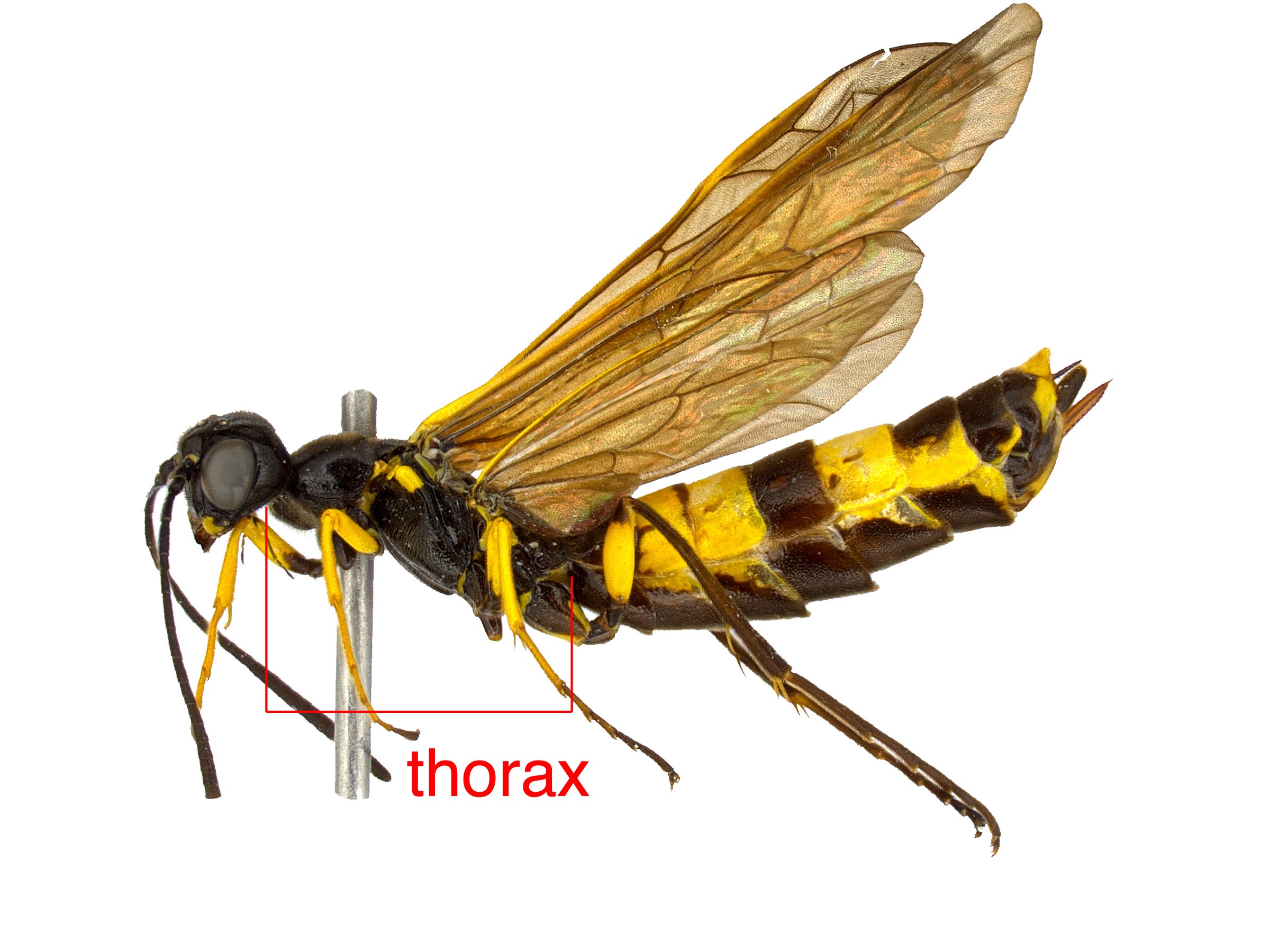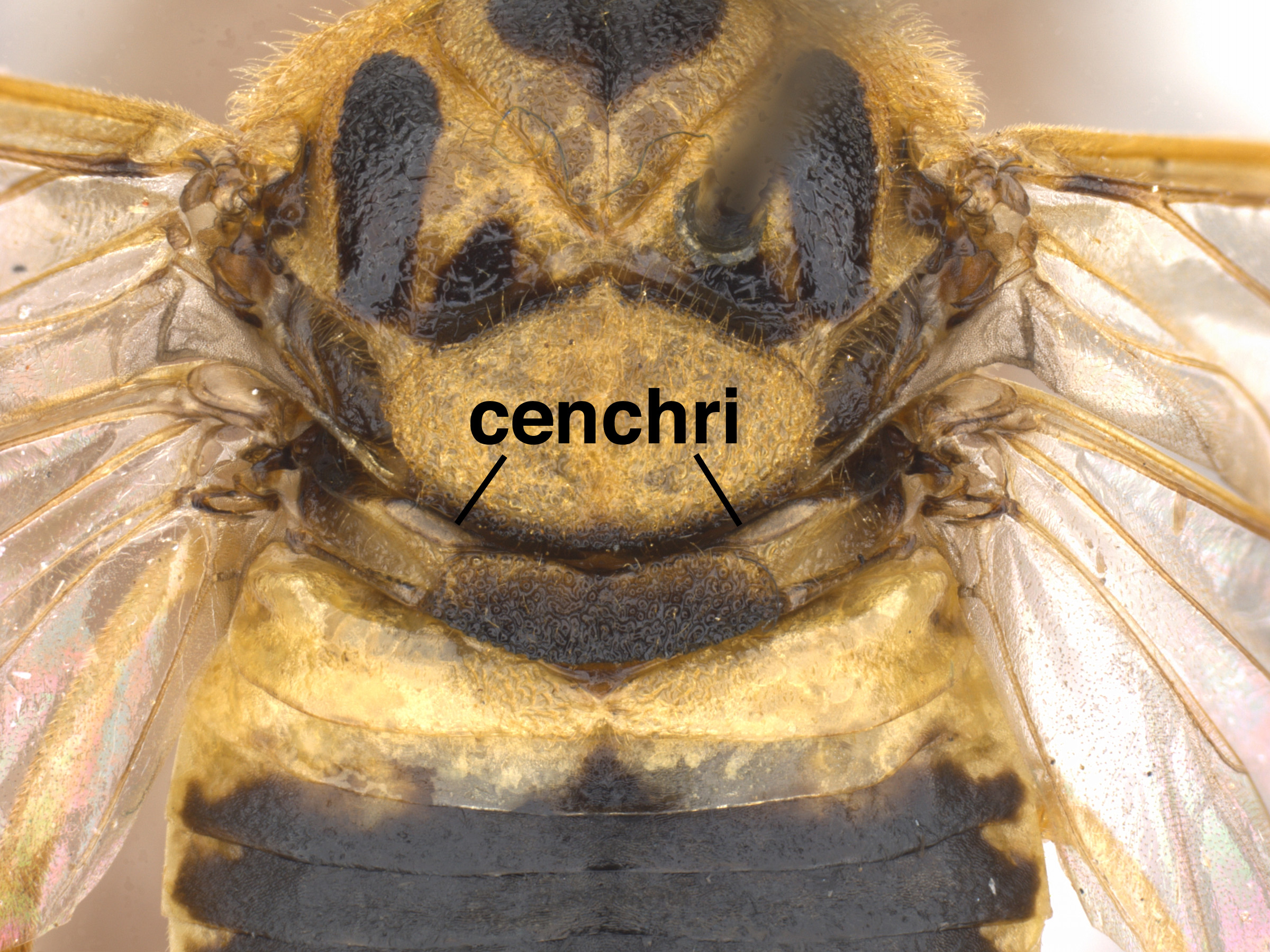Sawflies look very much like other wasps or bees of the order Hymenoptera. However, sawflies are a diverse group of families that vary greatly in appearance.
There are a few characteristics that all or most sawflies have in common. The characteristic that nearly always sets sawflies apart from wasps and bees is their lack of a narrow constricted "waist", where the thoraxthorax:
the second and middle segment of the body, between the head and abdomen
 and abdomenabdomen:
and abdomenabdomen:
the third and last segment of an insect's body; in sawflies this is usually made up of 11 segments (segments 9 and 10 often fused) come together. It can be difficult to see this characteristic in living animals or preserved specimens if they are posed poorly.
come together. It can be difficult to see this characteristic in living animals or preserved specimens if they are posed poorly.
Another morphological character unique to sawflies are cenchricenchrus:
a sclerotized eliptical lobe on the metascutum used to provide friction with underside of wings to hold them in place on the dorsum of the body while in rest
 , hardened lobes on the dorsaldorsal:
, hardened lobes on the dorsaldorsal:
of or on the top surface of the body or structure
hind surface of the thoraxthorax:
the second and middle segment of the body, between the head and abdomen
 . These aren't present in the family Cephidae, but are diagnostic for all other sawfly families.
. These aren't present in the family Cephidae, but are diagnostic for all other sawfly families.
Because variation in appearance of sawflies is high, the best tool for recognizing sawflies is having an idea of the general morphology of each of the 12 families. Some families are wasp-like, with long, smooth, slender bodies (Cephidae, Siricidae), while some are bee-like with stouter, hairier bodies (Cimbicidae). Some are very small and may be mistaken for small bees or flies (Argidae, Pergidae, Diprionidae) or parasitic wasps (Orussidae). See the photos below for an example and brief description of each of the families included in this tool.
Sawfly larvaelarva:
the immature stage of holometabolous insects
 are easily confused with butterfly or moth larvaelarva:
are easily confused with butterfly or moth larvaelarva:
the immature stage of holometabolous insects
 (order Lepidoptera) because of similar morphology and similar feeding behavior. LarvaeLarva:
(order Lepidoptera) because of similar morphology and similar feeding behavior. LarvaeLarva:
the immature stage of holometabolous insects
 of both groups are generally long and slender, with segmented bodies and round, sclerotizedsclerotized:
of both groups are generally long and slender, with segmented bodies and round, sclerotizedsclerotized:
hardened, rigid
head capsules.
The key feature distinguishing immature Symphyta from Lepidoptera is the legs. The first 3 body segments of the larvalarva:
the immature stage of holometabolous insects
 have thin, segmented, thoracicthoracic:
have thin, segmented, thoracicthoracic:
of or on the thorax
legs. The remaining body segments usually have fleshy, stubby appendages known as prolegs. Caterpillars have five or fewer pair, while sawfly larvaelarva:
the immature stage of holometabolous insects
 have more than six pairs of prolegs. Additionally, caterpillars have small hooks or hairs at the apexapex:
have more than six pairs of prolegs. Additionally, caterpillars have small hooks or hairs at the apexapex:
the end or most distal area of any structure
of the prolegs, called crochets. Sawflies do not have crochets.
In some cases, such as leaf miners and “slug” sawflies, the prolegs may be difficult to count or even impossible to see. In these specimens, the distinguishing character is the “eyes”, or stemmata on the head capsule. While sawfly larvaelarva:
the immature stage of holometabolous insects
 only have one pair, Lepidopterans can have many, usually six or more pairs of stemmata on the head capsule.
only have one pair, Lepidopterans can have many, usually six or more pairs of stemmata on the head capsule.